By Ashleigh West.
 The opportunity to attend college has never been easy, and women especially, are all too familiar with that long hard road. The University of Massachusetts Amherst was founded in 1863, originally under the name the Massachusetts Agriculture College, and did not begin admitting women until 1903, forty years after its initiation. With the number of women enrolled at MAC steadily increasing, there was still another matter to be tackled—where would they house all the women? And thus the Abigail Adams House was born in 1920, a fitting time in women’s achievements, with the addition of the Nineteenth Amendment to the Constitution ratified that very year.
The opportunity to attend college has never been easy, and women especially, are all too familiar with that long hard road. The University of Massachusetts Amherst was founded in 1863, originally under the name the Massachusetts Agriculture College, and did not begin admitting women until 1903, forty years after its initiation. With the number of women enrolled at MAC steadily increasing, there was still another matter to be tackled—where would they house all the women? And thus the Abigail Adams House was born in 1920, a fitting time in women’s achievements, with the addition of the Nineteenth Amendment to the Constitution ratified that very year.
 The Abigail Adams House, which housed around 100 female students, was located on North Pleasant Street, now home to the John W. Lederle Graduate Research Center, for after a devastating fire on Saturday October 28th 1962 and several attempts to restore the forty-year-old building; the House was demolished in 1967, to make way for the future GRC. Originally, the Abigail Adams House was to be erected atop Orchard Hill, as was the hopes of MAC President Kenyon L. Butterfield, who looked further into the future and dreamed of a whole women’s agriculture college up on the Hill. Unfortunately, for reasons unexplained, this was not the case and the building of Massachusetts Agriculture Culture’s first women’s dormitory began in 1919.
The Abigail Adams House, which housed around 100 female students, was located on North Pleasant Street, now home to the John W. Lederle Graduate Research Center, for after a devastating fire on Saturday October 28th 1962 and several attempts to restore the forty-year-old building; the House was demolished in 1967, to make way for the future GRC. Originally, the Abigail Adams House was to be erected atop Orchard Hill, as was the hopes of MAC President Kenyon L. Butterfield, who looked further into the future and dreamed of a whole women’s agriculture college up on the Hill. Unfortunately, for reasons unexplained, this was not the case and the building of Massachusetts Agriculture Culture’s first women’s dormitory began in 1919.
 While not much is known about the Abigail Adams House in its actual existence, the dedication and naming process of the building was quite a lengthy and publicized process. In the Spring of 1920 a contest was open to all Massachusetts high school and Home Economic club girls for the submission of their choice of name for the new women’s building. There were many regulations, such as: the name could not be from any living person at the time, the name had to be of a Massachusetts woman, and she must have pertained to agriculture in some way. A reward of twenty-five dollars was offered, which is roughly $280 today, as well as recognition at the dedication ceremony to be held on October 8th 1920. All submissions were directed to Miss Edna L. Skinner, the namesake of the future Skinner Hall and the Advisor of Women at MAC, but the Board of Trustees would make the final decision. The contest closed on July 20th after receiving over forty entries, four of which all named Abigail Adams as the most desirable choice, among them Katherine B. Ehnes, the fourteen year old from Medfield, who ultimately won the contest for her eloquent explanation after much debate from the Trustees. Ehnes wrote Skinner on May 14th stating that Abigail Adams was an exemplary choice because she was “the first farmerette of Braintree”. She quoted James Morgan, a reporter for the Morgan County Weber River Independent Newspaper, when describing Adams as the “mother of the republic [who] had to stay home to rock the cradle, cook…and tend to the farm, milking and churning, knitting and darning, teaching and praying, toiling and saving, she supported the family, [and] helped her husband’s progress”. Ehnes stressed, “To Abigail Adams alone belongs the glory of being one of the most interesting women in ‘Farming’ or ‘Country Life’”.
While not much is known about the Abigail Adams House in its actual existence, the dedication and naming process of the building was quite a lengthy and publicized process. In the Spring of 1920 a contest was open to all Massachusetts high school and Home Economic club girls for the submission of their choice of name for the new women’s building. There were many regulations, such as: the name could not be from any living person at the time, the name had to be of a Massachusetts woman, and she must have pertained to agriculture in some way. A reward of twenty-five dollars was offered, which is roughly $280 today, as well as recognition at the dedication ceremony to be held on October 8th 1920. All submissions were directed to Miss Edna L. Skinner, the namesake of the future Skinner Hall and the Advisor of Women at MAC, but the Board of Trustees would make the final decision. The contest closed on July 20th after receiving over forty entries, four of which all named Abigail Adams as the most desirable choice, among them Katherine B. Ehnes, the fourteen year old from Medfield, who ultimately won the contest for her eloquent explanation after much debate from the Trustees. Ehnes wrote Skinner on May 14th stating that Abigail Adams was an exemplary choice because she was “the first farmerette of Braintree”. She quoted James Morgan, a reporter for the Morgan County Weber River Independent Newspaper, when describing Adams as the “mother of the republic [who] had to stay home to rock the cradle, cook…and tend to the farm, milking and churning, knitting and darning, teaching and praying, toiling and saving, she supported the family, [and] helped her husband’s progress”. Ehnes stressed, “To Abigail Adams alone belongs the glory of being one of the most interesting women in ‘Farming’ or ‘Country Life’”.
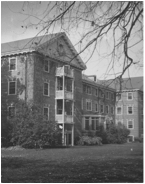 Abigail Adams was the first choice for the name of the new dormitory, but was shot down by the Trustees in August. With the dedication ceremony only two months away, the Committee On The Women’s Dormitory submitted two additional names from the contest entries—their second choice being Wolcott House, the third Mary Mattoon House—to be considered by the Trustees. The deadline was looming—just over a week away—when in a rather audacious letter, especially given the time, Edna Skinner urged President Butterfield on September 29th to “encourage the Trustees to decide upon the dormitory name before the dedication exercises” on October 8th. She wittily remarked that there “will be absolutely no other fitting occasion for the announcement of the name” and that it would “be most unfortunate if the building is left nameless at the close of the dedication exercises”.
Abigail Adams was the first choice for the name of the new dormitory, but was shot down by the Trustees in August. With the dedication ceremony only two months away, the Committee On The Women’s Dormitory submitted two additional names from the contest entries—their second choice being Wolcott House, the third Mary Mattoon House—to be considered by the Trustees. The deadline was looming—just over a week away—when in a rather audacious letter, especially given the time, Edna Skinner urged President Butterfield on September 29th to “encourage the Trustees to decide upon the dormitory name before the dedication exercises” on October 8th. She wittily remarked that there “will be absolutely no other fitting occasion for the announcement of the name” and that it would “be most unfortunate if the building is left nameless at the close of the dedication exercises”.
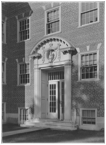 In an October 11th article for New Salem’s “The Transcript”, E. O. Marshall reported on the Abigail Adams House dedication, for which the need for more farm homes and farm service were themes of the sixteen speakers’ addresses. Marshall wrote, “Appropriately, this home for 100 girls is provided just as women are entering new political duties and will need every facility for improvement”. As if the newly built dormitory alone will better the women as citizens, and with their newly appointed right to vote, they so desperately need “improvement” now that they are actually allowed to utilize their freedoms. The article itself quickly departed from coverage of the new dormitory—with no mention on the thoughts of the women about the House, the process of its existence, or its future—preaching instead of the advantages to agricultural life over those of the weak and ignored city dwellers, which have “no room to store half a loaf of bread” (Marshall). Little praise or recognition was given to the women for their long awaited achievement.
In an October 11th article for New Salem’s “The Transcript”, E. O. Marshall reported on the Abigail Adams House dedication, for which the need for more farm homes and farm service were themes of the sixteen speakers’ addresses. Marshall wrote, “Appropriately, this home for 100 girls is provided just as women are entering new political duties and will need every facility for improvement”. As if the newly built dormitory alone will better the women as citizens, and with their newly appointed right to vote, they so desperately need “improvement” now that they are actually allowed to utilize their freedoms. The article itself quickly departed from coverage of the new dormitory—with no mention on the thoughts of the women about the House, the process of its existence, or its future—preaching instead of the advantages to agricultural life over those of the weak and ignored city dwellers, which have “no room to store half a loaf of bread” (Marshall). Little praise or recognition was given to the women for their long awaited achievement.
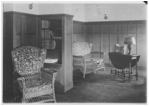 The Abigail Adams House, more affectionately referred to by its residents as “The Abbey”, was designed in the Georgian-revival style; a three-story brick building equipped with a reception hall, living room, two parlors, a fireplace, a housemother’s sitting room, an office, a laundry room located in the basement, and kitchenettes. The room costs were priced at $75 each in 1920, which is roughly $862 today, and it is not known whether the rooms were always shared, though in a 1948 scrapbooked article by Sandra Feingold, she noted that the Abbey has more single rooms than any other dorm on campus.
The Abigail Adams House, more affectionately referred to by its residents as “The Abbey”, was designed in the Georgian-revival style; a three-story brick building equipped with a reception hall, living room, two parlors, a fireplace, a housemother’s sitting room, an office, a laundry room located in the basement, and kitchenettes. The room costs were priced at $75 each in 1920, which is roughly $862 today, and it is not known whether the rooms were always shared, though in a 1948 scrapbooked article by Sandra Feingold, she noted that the Abbey has more single rooms than any other dorm on campus. 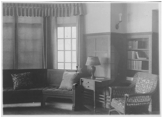 She also describes the Abbey as a “friendly close-knit dormitory”, especially due to its “comforts”, such as dark wood paneling, a spacious lounge, bay windows, the fireplace, a garden, and a grand piano. The Abbey boasted numerous artworks, including a portrait of its namesake, which hung in the lobby. The Abbey was also used as a barracks during World War II, the girls being temporarily displaced from their happy home.
She also describes the Abbey as a “friendly close-knit dormitory”, especially due to its “comforts”, such as dark wood paneling, a spacious lounge, bay windows, the fireplace, a garden, and a grand piano. The Abbey boasted numerous artworks, including a portrait of its namesake, which hung in the lobby. The Abbey was also used as a barracks during World War II, the girls being temporarily displaced from their happy home. 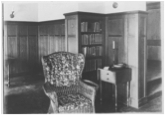 Besides the ruling housemother—who enforced the 7:30pm curfew, among other regulations such as the girls must be at least clothed in a robe if outside their rooms, popular music is considered “undesirable” on Sundays, beds must be made by 9:00am, and bathrooms should not be used after 10:00pm—the Abbey also included a House Chairman, who was in fact a woman, Counselors, a Dorm Senator, and a Social Chair, all of whom were female students elected by their fellow housemates.
Besides the ruling housemother—who enforced the 7:30pm curfew, among other regulations such as the girls must be at least clothed in a robe if outside their rooms, popular music is considered “undesirable” on Sundays, beds must be made by 9:00am, and bathrooms should not be used after 10:00pm—the Abbey also included a House Chairman, who was in fact a woman, Counselors, a Dorm Senator, and a Social Chair, all of whom were female students elected by their fellow housemates.
 Sadly, on Saturday October 28th 1962, a fire that “spread rapidly through combustible acoustic ceiling tiles” (YouMass) destroyed the Abigail Adams House and all its glory and comfort. An article from “The Bridgeport Telegram” reported on Tuesday October 30th 2012, that faulty wiring could also be related to the $300,00 damages the Abbey suffered, which would be roughly $3.5 million by today’s standards. The fire damage was devastating and the Abbey was almost completely burnt down. The female students were displaced for good, with the campus not becoming co-ed in the dormitories until 1970; many of them completely lost all of their belongings in the destruction. Besides the damage the University suffered to its bank accounts, little was reported about the fire that destroyed the first women’s dormitory.
Sadly, on Saturday October 28th 1962, a fire that “spread rapidly through combustible acoustic ceiling tiles” (YouMass) destroyed the Abigail Adams House and all its glory and comfort. An article from “The Bridgeport Telegram” reported on Tuesday October 30th 2012, that faulty wiring could also be related to the $300,00 damages the Abbey suffered, which would be roughly $3.5 million by today’s standards. The fire damage was devastating and the Abbey was almost completely burnt down. The female students were displaced for good, with the campus not becoming co-ed in the dormitories until 1970; many of them completely lost all of their belongings in the destruction. Besides the damage the University suffered to its bank accounts, little was reported about the fire that destroyed the first women’s dormitory. 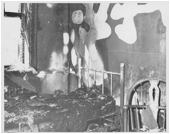 There were no repots of whether anyone was injured, nothing was stated on the students’ reactions to the fire, let alone the loss of their home, or where the girls would be relocated, and there was utter silence on the fact that this significant piece in the history of the University was destroyed. Several attempts were made to restore the Abigail Adams House, but it was never again a dormitory. Until 1967, the Abbey was used as offices for faulty—a shell of its former glory—but it was demolished that year to make way for the John W. Lederle Graduate Research Center, to support the ever-growing research in the sciences, which at the time was majoritarily a boys-only club. The first women’s dormitory was destroyed for a second time—this one was for good.
There were no repots of whether anyone was injured, nothing was stated on the students’ reactions to the fire, let alone the loss of their home, or where the girls would be relocated, and there was utter silence on the fact that this significant piece in the history of the University was destroyed. Several attempts were made to restore the Abigail Adams House, but it was never again a dormitory. Until 1967, the Abbey was used as offices for faulty—a shell of its former glory—but it was demolished that year to make way for the John W. Lederle Graduate Research Center, to support the ever-growing research in the sciences, which at the time was majoritarily a boys-only club. The first women’s dormitory was destroyed for a second time—this one was for good.
Unless one goes digging deep within the decades of the University’s history, sifting through the numerous folders, documents, journals, biographies, articles, photographs, books, the history of the Abigail Adams House remains hidden, a secret stuck in the shadows. The Abigail Adams House was and still is an important achievement and a significant aspect to the history of the University of Massachusetts Amherst and the women themselves on this campus, past and present, yet its existence remains largely unknown to the majority, if not all, of the campus community. The Class of 2013, myself included, marks the 100th class of women graduates from UMass Amherst, yet even a decade into the new millennium, women everywhere are still fighting for equality. With every step we get a little closer, and there are more opportunities for women than ever before imagined, but how many classes of women must graduate, must prove themselves “worthy”, before we are all truly equal?
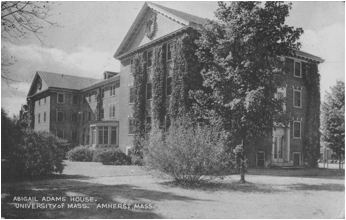
Works Cited
“Abigail Adams House.” YouMass: UMass Amherst As A Wiki. Special Collections & University Archives, UMass Amherst Libraries, 18 2012. Web. 1 Nov 2012. http://www.library.umass.edu/spcoll/youmass/doku.php?id=buildings:a:adams.
“Abigail Adams House: House Regulations.” Dean of the College William L. Machmer- Box 15: Folder 1: Skinner, Edna L. Five College Archives Digital Access Project: University of Massachusetts , n.d. Web. 1 Nov 2012. http://clio.fivecolleges.edu/umass/6-1dean-of-college/b15f1skinner/19260900/01.htm.
“Contest Open To All Massachusetts Girls.” President Kenyon L. Butterfield – Selected Records Related to Women’s Education: Folder 56: Abigail Adams House. Five College Archives Digital Access Project: University of Massachusetts , n.d. Web. 1 Nov 2012. http://clio.fivecolleges.edu/umass/3-1president/abigail-adams/1920contest/.
Ehnes, Katherine B.. “Contest Submission.” President Kenyon L. Butterfield – Selected Records Related to Women. Five College Archives Digital Access Project: University of Massachusetts , 14 1920. Web. 1 Nov 2012. http://clio.fivecolleges.edu/umass/3-1president/abigail-adams/19200514/index.shtml?page=1.
Feingold, Sandra. “Abigail Adams Dorm Shorn Of Stand-Offish Air.” Dean of Women: Helen Curtis- Folder 23: Women’s Residence Halls. Five College Archives Digital Access Project: University of Massachusetts , n.d. Web. 1 Nov 2012. http://clio.fivecolleges.edu/umass/30-3dean-of-women/23residence/index.shtml?page=2.
Jefferson, Lorina P.. “Supplementary Report of Committee on the Women’s Dormitory.”President Kenyon L. Butterfield – Selected Records Related to Women. Five College Archives Digital Access Project: University of Massachusetts , n.d. Web. 1 Nov 2012. http://clio.fivecolleges.edu/umass/3-1president/abigail-adams/19200800supprpt/.
Marshall, E. O.. “The Transcript: “Dormitory for Women”.” President Kenyon L. Butterfield – Selected Records Related to Women’s Education: Folder 56: Abigail Adams House. Five College Archives Digital Access Project: University of Massachusetts , 11 1920. Web. 1 Nov 2012. http://clio.fivecolleges.edu/umass/3-1president/abigail-adams/19201011/.
Rand, Frank Prentice. Yesterdays at Massachusetts State College,1863-1933. Amherst: The Associate Alumni Massachusetts State College, 1933. 148. eBook.
Skinner, Edna L.. “Letter: To Kenyon L. Butterfield .”President Kenyon L. Butterfield – Selected Records Related to Women. Five College Archives Digital Access Project: University of Massachusetts , 29 1920. Web. 1 Nov 2012. http://clio.fivecolleges.edu/umass/3-1president/abigail-adams/19200929skin/.
“$300,000 Fire Probed.” Bridgeport Telegram[Bridgeport, CT] 30 Oct 1962, Page 24. Web. 1 Nov. 2012. http://newspaperarchive.com/flashviewer/seofullviewer?img=83012900.
